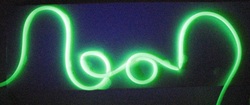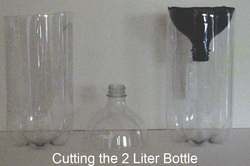

| Observations |
|
 Well, its not really a neon sign. There is no transformer, no glass tubing, and no neon gas. I simply extracted the dye from a Sharpie Accent Highlighter. Once diluted with water, and transferred to aquarium plastic tubing in the shape of the word, it comes to life. The light used is ultraviolet blacklight. In this case, a small LED UV flashlight. The dye is exhibiting fluorescence, which is the absorption of light in one wavelength, (Ultraviolet) and re-emission in the visible spectrum. The dye is easy to obtain as the following photo shows:  After removing the end cap and the fiber insert containing the dye, use a razor to cut the insert. I use distilled water but any kind will work. About 1 cup works well, but more can be used if necessary. The dye is fairly safe but the MSDS (Material Safety Data Sheet) does not identify the dye. See MSDS here: I have seen other demonstrations with this dye, so look around on the net and have some fun. The next post will cover another easy to use fluorescent dye. Brilliant!
0 Comments
 This is a simple yet very effective trap for flies, mosquito's, wasps, and even fruit flies. The key to the trap is in the bait. For flies, any fresh rotting meat will work. Raw hamburger or similar works just fine. The more disgusting the smell, the greater the fly response. For wasps, and fruit flies, a piece of banana or a sugar solution usually works. The banana gives off ethyl acetate gas odor and that is attractive to several species of insects. The recipe for mosquito attractant follows the next photo and requires some explanation. In this trap, I used a 2 liter plastic bottle, but smaller will also work as well. Begin by placing a straight edge along the bottle as shown and mark just behind where the curved top starts. And then cut the top off as illustrated:  I painted the funnel part black to show how it is inserted. (The white disk in the lead photo is 1/8 inch foam board that is perforated to catch fruit flies for examination). If the funnel is too loose, just add some tape to secure. Put the selected bait in the bottom, add the funnel, and catch the enemy! The recipe for mosquito's is more controversial. We do know that they are attracted to carbon dioxide from skin and breath. But, it is a bit more complicated than that. But this recipe does generate CO2 and worth trying: Mix 200 ml of warm water with 1/3 cup of sugar. Add 1 package of dry yeast that is used to make bread, available at any market. The fermentation will slowly generate CO2 and will do so for about two weeks. I have one going now and will report as results come in. When the trap is full you can cover the top and place in the refrigerator to kill the insects. Alternatively, a cotton ball can be saturated with ammonia and dropped in the trap while covering the top. I have used this approach for flies and it has been very successful. Here are some additional thoughts and speculation about mosquito's: It is only the female that bites so that she can propagate the species. Researches have found that when possible, they will bite the feet over any other part of the body. So, in some other countries they have used dirty socks with some success as bait. My speculation is that there is a concentration of octenol, another favorite attractant in the socks. Good hunting...  Whether it is holding two three- volt coin cells together for a temporary 6 volt supply, or closing a a bag top, the clothespin is one of the most ubiquitous household devices ever. It is impossible to describe the many uses of this combination of metal spring and wood. A quick look around the net will show many uses and there will be more. I cannot imagine being without this option.
The earliest patent that I have found was 1853, and that was a simple peg with a slot that spread under force. I am certain that there were many predecessors that never went through the patent office. For example, the Shaker's developed several peg-like pins for that purpose and they were never patented or sold to the public. And with all of the uses, it can also be used to hang clothes! In my constant effort to find and eliminate woodchucks from my garden, (See Post on 5/13 "Large Pest"), I found this stranger in the trap. It is an opossum, which is a Western Hemisphere marsupial. It is somewhat different from the possum, that is principally found in Australia. The interesting fact is that they play dead, and look to be so as in photo 1. But, as I approached the trap, he, or she, came back to life, as in photo 2. This one put on quite a show with hissing, barking, and baring its teeth. I actually had difficulty letting it out as it kept going for my hand. This one had my attention! They have a prehensile tail and are omnivores, but really will eat whatever is available, apparently including people hands. As I have never seen one in my garden, I decided to let this one move on. Of course, they are nocturnal and it may come back tonight. But I think that I made him/her as nervous as it made me. I guess that they like broccoli as much as woodchucks...
|
Archives
June 2021
Categories
All
|